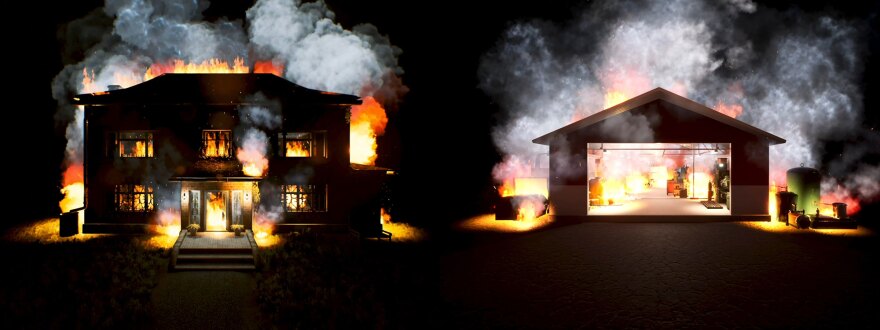Two Tijuana-born artists based in Mexico City are set to open solo exhibitions at Best Practice gallery in Logan Heights this weekend.
Andrew Roberts' video-game influenced digital installation is called "A house on fire is a ghost, a factory on fire is a specter." The work connects family history and trauma with the arms industry.
Mauricio Muñoz's exhibition, "A thirst for misery" digs into the idea of "celebrity misery," transforming mugshots and paparazzi snaps into paintings.

Longtime partners, Muñoz and Roberts co-direct Deslave, a curatorial project and — up until the pandemic — a former gallery space in Tijuana. Deslave was founded to explore the emerging talent in the region and share work with art fairs and international audiences. They've since decentralized the project, and relocated to Mexico City, where they're better able to share their work and the art they curate with collectors for now.
Two grandfathers, two countries, one arms industry
Roberts, who was born in Tijuana, said that the work in "A house on fire is a ghost, a factory on fire is a specter" was inspired by two fires, and the links between his paternal and maternal grandfathers, one American and one Mexican.
"When [my paternal grandfather] was 18 and 19, he worked for a corporation called Remington, that is an arms manufacturing corporation. And I found that my maternal grandfather, my Mexican grandfather also worked for the same corporation in Cuernavaca, a city that is close to Mexico City. He worked exactly on the same gear that my paternal grandfather was fighting with in the Vietnam War," Roberts said.
After the war, the parallels continued, and trauma and fiery tragedy befell both men.
Roberts' maternal grandfather opened his own maquila in Tijuana, but it was lost to a fire. In America, after the paternal grandfather returned from the Vietnam War, he suffered from severe PTSD. Roberts said the grandfather dropped his family off in their California home and set it on fire. They all escaped, but the grandfather was institutionalized for the rest of his life, and the family also lost everything to the fire.

The format of this exhibition is also rooted in his Mexican grandfather's factory: Roberts first became interested in 3D modeling when working in his grandfather's new factory in Tijuana, and as a teen, Roberts would help with anything computer-related.
The video game-influence in his work is also a representation of the links between the arms industry and video games.
"It's almost impossible for me to separate the history of video games and the history of war technology because they are born from the same place," Roberts said.

The exhibition features two-channel videos made from 3D renderings of long-lost buildings: one that represents the house that his American grandfather burned down, and another for the Tijuana factory that also burned. The two-part video work is accompanied by narration that describes the relationship between Mexico and the United States in terms of the military-industrial complex. The narration is in both English and Spanish.
"A lot of my work deals with personal things, but they are more about trying to understand certain larger things, and this specific work — I found in both of my grandfather figures the perfect example to analyze how the arms industry works between Mexico and the U.S.," Roberts said. "I'm very interested in America's interventionist policies in other countries and how they manage geopolitical resources and the territory. For me, the arms industry is just a part to understand all those complex problems. And in my own family I found that dynamic in a very basic way."
A collective obsession with celebrity misery
Best Practice cofounder Joe Yorty said that the gallery constructed a temporary wall in the middle of the Best Practice space for the purpose of showing both exhibitions at the same time and allowing each exhibition to be distinct.
On the other side of the wall, Mauricio Muñoz will display a body of paintings they based on the idea of celebrity misery. The exhibition is called "A thirst for misery."

Each painting is based upon a photograph of a celebrity caught at their worst. Muñoz said it's a fascination that seemed to blossom in the 2000s, when celebrity "misery" was at the forefront of pop culture in a way they hadn't observed it before. Muñoz referred to it as a sort of breakthrough — with the likes of Paris Hilton or the Kardashians constantly in the public discourse, and sensationalist celebrity and paparazzi news sites like PerezHilton.com or TMZ on the rise.
"I found the roots of today's obsession and eagerness to consume and see the misery of the celebrities," Muñoz said. "It's almost like a voyeuristic thing to see all these celebrities suffering, or seeing them in some kind of trouble."
Muñoz painted this specific body of work all within the last year, and each painting is based upon a mugshot.

These images are startling in their familiarity — it's unsettling and slightly implicating that these mugshots have been so burned into the collective consciousness that they're recognizable after Muñoz's brushstrokes transform the image into an almost abstract, textured swirl of color.
It's also an intimate act — Muñoz spent anywhere from eight hours to a day and a half painting each work, staring at the celebrity while they're arguably at some sort of rock bottom.
"But in the end, all these celebrities just get away with whatever they did," Muñoz added.
"A thirst for misery" by Mauricio Muñoz and "A house on fire is a ghost, a factory on fire is a specter" by Andrew Roberts will be on view at Best Practice gallery in the Bread and Salt Complex Jan. 8 through Feb. 12, 2022. An opening reception will take place Saturday, Jan. 8 from 5-8 p.m., with regular gallery hours Tuesday through Sunday 11 a.m. to 4 p.m.
Andrew Roberts and Mauricio Muñoz at Best Practice
- Add to Google Calendar
- Add to Outlook Calendar
Download ICS file






